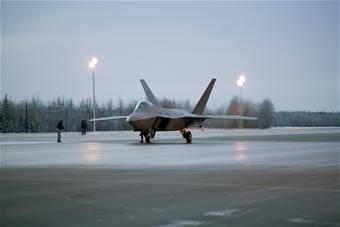The A ir Force has just concluded three weeks of cold-weather testing for the new F-22A stealth fighter at Eielson AFB, Alaska. A contingent from the 411th Flight Test Squadron at Edwards AFB, Calif., traveled to Eielson to test the Raptor’s ability to stop on poor surfaces, whether snow or ice, which is a “challenge for every Air Force jet,” said test pilot Maj. Jack Fischer. The aircraft’s anti-skid system is unique to the F-22 and is “like the anti-lock brake system in your car—but on steroids,” explained Fischer. The result, he said, was that the fighter demonstrated “incredible brake-system stability on low-friction surfaces.” (Report by A1C Nora Anton.)
ir Force has just concluded three weeks of cold-weather testing for the new F-22A stealth fighter at Eielson AFB, Alaska. A contingent from the 411th Flight Test Squadron at Edwards AFB, Calif., traveled to Eielson to test the Raptor’s ability to stop on poor surfaces, whether snow or ice, which is a “challenge for every Air Force jet,” said test pilot Maj. Jack Fischer. The aircraft’s anti-skid system is unique to the F-22 and is “like the anti-lock brake system in your car—but on steroids,” explained Fischer. The result, he said, was that the fighter demonstrated “incredible brake-system stability on low-friction surfaces.” (Report by A1C Nora Anton.)
The United States Air Force is flying less than historic norms and funding for acquisition and readiness is on a path to further hollow out this too small and old force to that is incapable of sustaining an enduring combat air campaign.

